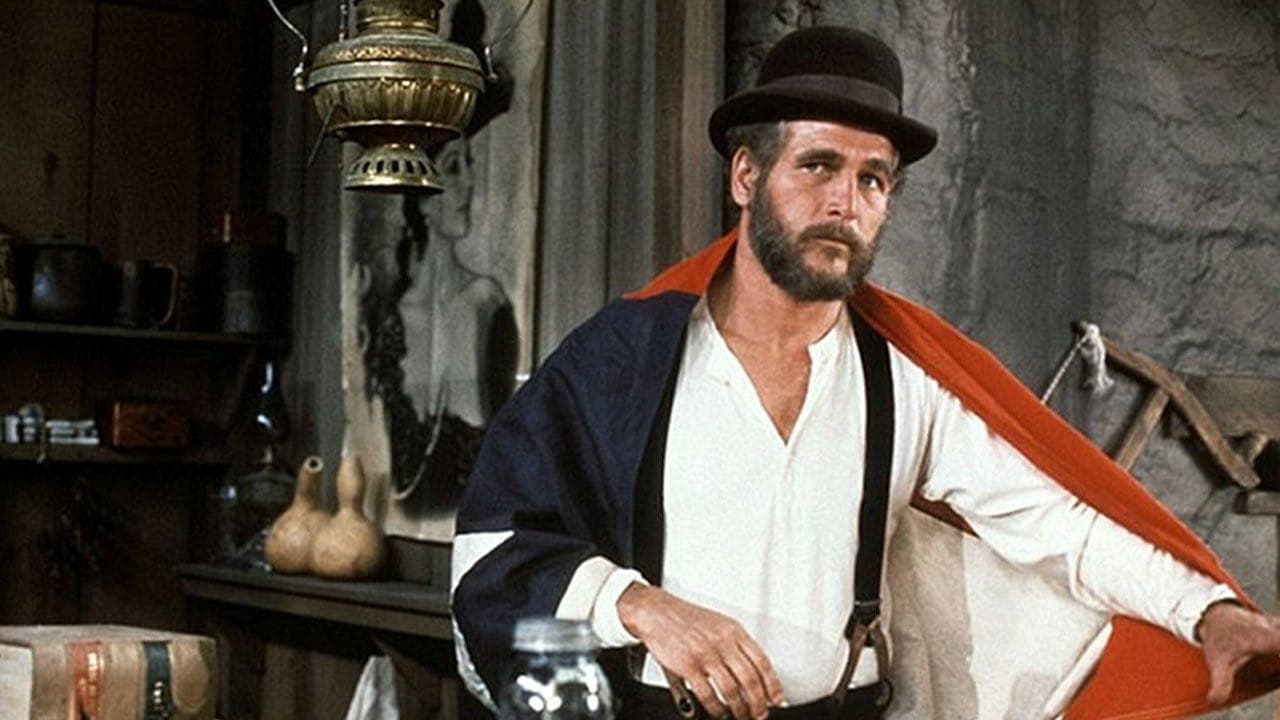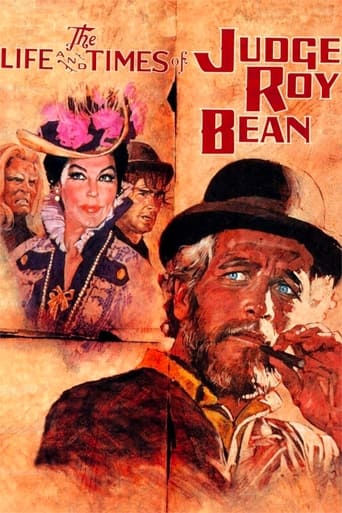

Historical accuracy takes a pretty significant hit in this Western, but that shouldn't affect one's enjoyment of the film. As he did a handful times in his career, Paul Newman portrays an Old West character bringing order, progress, civilization and peace to the self appointed one horse town of Vinegarroon, Texas, and he doesn't care who he has to kill to get it. The film relies on quite a few one shot cameos of actors who show up only to be gunned down or hung by Judge Roy Bean (Newman). The most outrageous of these occurs when albino Bad Bob (Stacy Keach) rides into town gunning for the Judge. I like to think that Bean's reaction to Bob's insults provided the inspiration for a similar scene in 1995's "The Quick and the Dead".There's also the running story line of Bean's infatuation with actress Lily Langtry who he never gets to meet, though the picture's finale affords a sentimental reaction from the character portrayed by Ava Gardner. Earlier in the story, Snake River Rufus Krile (Neil Summers) had the distinct misfortune to desecrate a poster of Miss Langtry for which he paid dearly. That was a scene to rival Bad Bob's undoing.Victoria Principal made a notable movie debut here as a Mexican senorita who nursed Bean back to health following his first unfortunate encounter in Texas, ultimately moving in and providing him with a child before her tragic end. Following a whirlwind flash forward of twenty years, Jacqueline Bisset picks up the slack as Bean's daughter Rose desiring to keep his legacy alive amid an oil boom ushering out the final days of the Old West.Considering the colorful life of the real Roy Bean, I'm sure many Western movie fans like myself would welcome a modern, more accurate treatment of the legendary judge dispensing law West of the Pecos. I'd certainly look forward to experiencing old time justice as the handmaiden of the law, or vice versa depending on the circumstance.
... View MoreTITLE: THE LIFE AND TIMES OF JUDGE ROY BEAN opened in theaters in the United States on December 18 1972 starring Paul Newman, Victoria Principal, and Anthony Perkins and it will take you 2 hours to watch this movie. THE LIFE AND TIMES OF JUDGE ROY BEAN was a 1972 western film written by John Milius, directed by John Huston, and starring Paul Newman (at the height of his career, between Butch Cassidy and the Sundance Kid and The Sting). It was loosely based on the real-life, self-appointed frontier judge. SUMMARY: An outlaw, Roy Bean, rides into a West Texas border town called Vinegaroon by himself. The customers in the saloon beat him, rob him, toss a noose around him, and let Bean's horse drag him off. A young woman named Maria Elena finds and helps him. Bean promptly returns to town and shoots all those who did him wrong. With no law and order, he appoints himself judge and "the law west of the Pecos" and becomes the townspeople's "patrone." Bean renames the saloon The Jersey Lilly and hangs a portrait of a woman he worships but has never met, Lillie Langtry, a noted actress and singer of the 1890s. When a band of thieves come to town (Big Bart Jackson and gang members Nick the Grub, Fermel Parlee and Whorehouse Lucky Jim), rather than oppose them, Bean swears them in as lawmen. The new marshals round up other outlaws, and then claim their money after Bean sentences them to hang. Dispensing his own kind of frontier justice, Bean lets the marshals hang Sam Dodd and share his money. When a drunk shoots up a saloon, Bean doesn't mind, but when Lily's portrait is struck by a bullet, the fellow is shot dead on the spot. Prostitutes are sentenced to remain in town and keep the marshals company.QUESTIONS: Who was Maria Elena? Who was the mountain man? What kind of gift did he give to Maria? Why did Bean go to San Antonio? What did the Judge bring back to Maria? MY THOUGHTS: I loved this movie. There was action and drama right from the beginning. I thought the job that Paul Newman did in the role, as Judge Roy Bean was great. This Western had something in it as most Westerns don't and that was comedy. One of the best is when Maria catches the Judge with another woman an she takes after him with a shotgun. I bought this movie however for Victoria Principal and I wasn't disappointed. This was Victoria introduction and she was great. She was very young in this picture but her acting was great. You didn't get to see much of her because it was a Western, however because of her beauty and acting I'm giving this movie 10 weasel stars.
... View MoreIn "The Life and Times of Judge Roy Bean", the Judge (Paul Newman) hangs dozens of men and develops quite a reputation for his strange and violent form of justice. In reality, Bean WAS famous for his odd sentences and occasional disregard for the law, but only one man was ever actually hung by the judge! In many, many other ways, the film takes HUGE liberties with history--and the story of Bean is only a shadow of the real man. So if you are looking for a history lesson, look for some other film! Aside from the bad history, this film struck me as the product of a schizophrenic writer! Parts of the movie were quite funny--followed by LONG deadly serious parts. And, near the very end of the film it became a completely different film altogether--a terrible action pic. If not schizophrenic, it sure looked as if three different writers were given three portions of the film and never consulted with each other!! It's a real shame, as the first half (or so) of the film is quite good--fun, silly and engaging. The last half is maudlin, slow and, in parts, simply awful. The worst is when, completely out of the blue, Bean (who'd simply disappeared for much of the film--and the period was to have been 20 years) just suddenly shows up and behaves like Rambo!! Where did THIS come from and whose idea was this?! As a result, all the good of the first portion of the film is simply flushed away--and completely wasted. All in all, a thoroughly frustrating and wildly uneven film.A few notes about the film. Some of the comments early in the film about minorities (in the scene with Tab Hunter) are bound to offend--hold on to your seat! The film's director, John Huston, makes a small cameo as 'Grizzly' Adams--and it's a VERY odd cameo indeed. It's the first film of Victoria Principle--and she's oddly made up to look like a Mexican! Jacqueline Bisset is pretty much wasted in the film. Stacy Keach is almost unrecognizable as 'Bad Bob'--a funny portion of the film that, unfortunately, was too short and not enough.Also, after writing my review, I looked at the rest of the reviews. I was surprised how many of the folks gave this one a 10 considering how wildly uneven it was. Perhaps these votes were more votes for Newman--after all, he was an incredibly gifted actor--but the material in this film just didn't do him justice.
... View MoreOne thing that seems to come with movies about certain times and dates in history are these annoying,prudent nit-pickers who have to ruin a great movie by saying "this didn't happen and that didn't happen". To quote Client Eastwood at the end of The Gauntlet...nag! nag! nag! Doesn't anyone in this day and age just watch a movie for pure enjoyment and losing themselves in a story? Have we all become a nation of film critics and supposed realists that we have to pick a movie apart for not being 100% historically accurate?! You want the whole true story,then watch a Ken Burns documentary or PBS's American Experience! This movie is absolutely incredible. Starting with the way it is filmed,the scenery is great,in the sense of how empty and bleak yet somehow inviting it is. This has to be watched on a clean DVD copy to really be understood.Paul Newman plays his role so very convincingly,I sometimes forgot it was he being Judge Roy Bean. It seemed like a whole other person had taken over Paul's mind. His vengeful shoot-out in the whorehouse is not your standard western shoot-em up. Unlike in those films,he hits everyone he shoots and it's camera angles make it all the more real.There's so many other great players in this movie,I haven't the room to discuss them all but they do range from great to good. Victoria Principal played a her role so well as a Spanish girl,I mistakenly though she was Judge Bean's daughter later in the film. I don't see how someone finds her performance shallow,her character is a woman from a tiny village in Texas. It's a wonder she knows English at that time.Stacy Keach's brief moment in the film is witout a doubt the funniest scene. His long hair and goofy black clothes make him look like the Edgar Winter of cowboys! I disagree that Ava Gardner seems to old to be Beans object of fascination. Bean was in his late 30s/early 40s at the start and Miss Lily not much younger. She visits his town after Bean is gone,so it's perfectly fine.The overall story is quite riveting and doesn't need to be history book perfect to tell it. The old west from near the end of the 19th century had always had inconsistencies and exaggerations in it's stories and legends. The great point made here is where does upholding the law begin & end? At what point does it go from being just that,to being sadistic and out of control with power? Roy seems to go very far beyond drunk with power. He has his human moments in this movie which actually are moving but mostly he's a man who has placed himself above anything and others. The only thing I'd say that is quite out of place here is the very saccharine song sung by Andy Williams in the playful scene between Newman,Pricipal & the bear. Nothing against Mr. Williams' singing but it's a bit laughable in a movie that's mostly dark with comedic interludes. So for the great look of the film,the acting,the story and the direction of John Huston (who plays 'Grizzly Adams' in the film),I easily give this 10 stars.I don't care about the facts,just how good each player acts. (END)
... View More